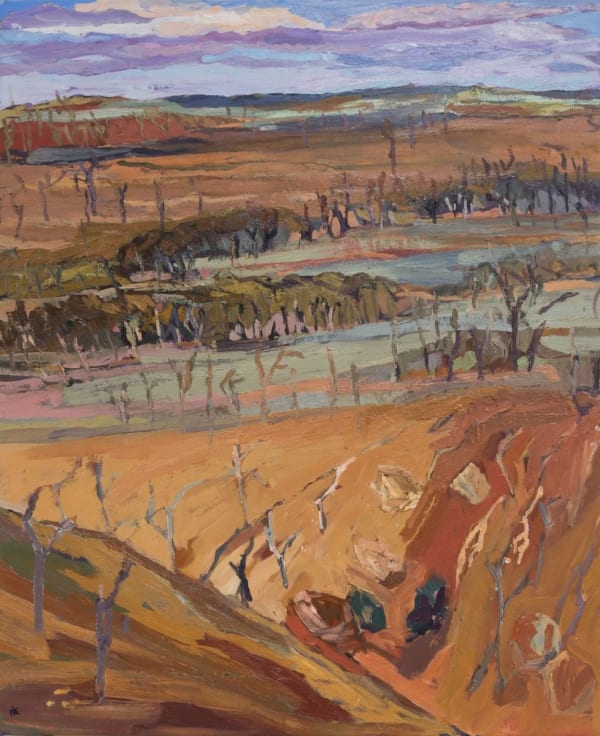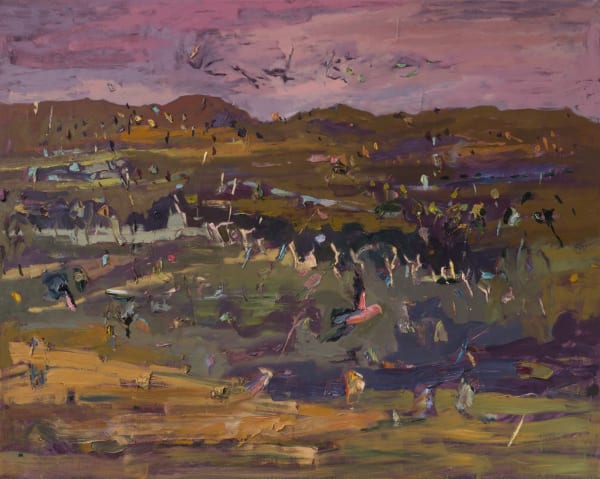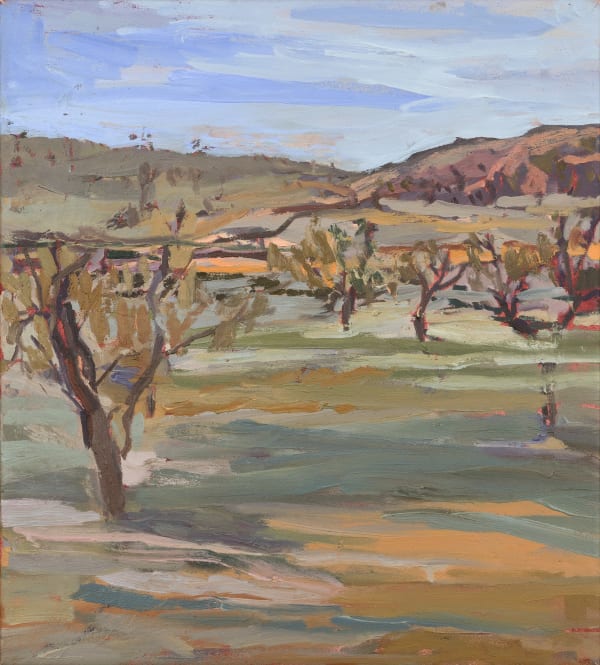Nicole Kelly: For What Binds
-
 Nicole KellyAn Echo of Rain, 2020oil on polyester87 x 71.5 cm, 89 x 73.5 cm (framed)
Nicole KellyAn Echo of Rain, 2020oil on polyester87 x 71.5 cm, 89 x 73.5 cm (framed) -
 Nicole KellyAs If Composed of , 2021oil on polyester132 x 107 cm, 134 x 109 cm (framed)
Nicole KellyAs If Composed of , 2021oil on polyester132 x 107 cm, 134 x 109 cm (framed) -
 Nicole KellyDrawn Over in Silver, 2020oil on polyester51 x 46 cm, 53 x 48 cm (framed)
Nicole KellyDrawn Over in Silver, 2020oil on polyester51 x 46 cm, 53 x 48 cm (framed) -
 Nicole KellyEvening Promise, 2020oil on polyester51 x 46 cm, 53 x 48 cm (framed)
Nicole KellyEvening Promise, 2020oil on polyester51 x 46 cm, 53 x 48 cm (framed) -
 Nicole KellyFor What Binds, 2021oil on polyester122 x 153 cm, 124 x 155 cm (framed)
Nicole KellyFor What Binds, 2021oil on polyester122 x 153 cm, 124 x 155 cm (framed) -
 Nicole KellyLeaving, as the Moon, 2021oil on polyester167.5 x 198 cm, 170 x 200.5 cm (framed)
Nicole KellyLeaving, as the Moon, 2021oil on polyester167.5 x 198 cm, 170 x 200.5 cm (framed) -
 Nicole KellyMore Distant Than Rain, 2020oil on polyester51 x 46 cm, 53 x 48 cm (framed)
Nicole KellyMore Distant Than Rain, 2020oil on polyester51 x 46 cm, 53 x 48 cm (framed) -
 Nicole KellyNight Entangled Trees, 2021oil on polyester138 x 167 cm, 141 x 170 cm (framed)
Nicole KellyNight Entangled Trees, 2021oil on polyester138 x 167 cm, 141 x 170 cm (framed) -
 Nicole KellyPattern on the Earth, 2021oil on polyester167.5 x 198 cm, 170 x 200.5 cm (framed)
Nicole KellyPattern on the Earth, 2021oil on polyester167.5 x 198 cm, 170 x 200.5 cm (framed) -
 Nicole KellySpread Out Against the Sky, 2021oil on polyester132 x 107 cm, 134 x 109 cm (framed)
Nicole KellySpread Out Against the Sky, 2021oil on polyester132 x 107 cm, 134 x 109 cm (framed) -
 Nicole KellyStirred By the Rain, 2021oil on polyester137 x 102 cm, 140 x 105 cm (framed)
Nicole KellyStirred By the Rain, 2021oil on polyester137 x 102 cm, 140 x 105 cm (framed) -
 Nicole KellyThe Moon Behind the Winter, 2021oil on polyester137 x 102 cm, 140 x 105 cm (framed)
Nicole KellyThe Moon Behind the Winter, 2021oil on polyester137 x 102 cm, 140 x 105 cm (framed) -
 Nicole KellyThis Duality, 2020oil on polyester51 x 46 cm, 53 x 48 cm (framed)Sold
Nicole KellyThis Duality, 2020oil on polyester51 x 46 cm, 53 x 48 cm (framed)Sold -
 Nicole KellyThreshold Between, 2020oil on polyester51 x 46 cm, 53 x 48 cm (framed)
Nicole KellyThreshold Between, 2020oil on polyester51 x 46 cm, 53 x 48 cm (framed) -
 Nicole KellyTo Seep In, 2020oil on polyester51 x 46 cm, 54 x 48 cm (framed)Sold
Nicole KellyTo Seep In, 2020oil on polyester51 x 46 cm, 54 x 48 cm (framed)Sold -
 Nicole KellyWhere the Sun Beats, 2020oil on polyester51 x 46 cm, 53 x 48 cm (framed)
Nicole KellyWhere the Sun Beats, 2020oil on polyester51 x 46 cm, 53 x 48 cm (framed) -
 Nicole KellyWhere They've Grown, 2021oil on polyester132 x 107 cm, 134 x 109 cm (framed)
Nicole KellyWhere They've Grown, 2021oil on polyester132 x 107 cm, 134 x 109 cm (framed)
The deeply layered paintings of Nicole Kelly posit natural landscapes as receptacles of slanted human narratives. Her evolving visual language conjures emotional and psychological cartographies that trace the artist’s own spatial experiences of the land, intimately observed and sensitively felt. While celebrating the profundity of the land, she also considers its sad acquiescence in a time of anthropogenic tenancy.
This dichotomy of power and passivity, tranquility and violence, trickles into Kelly’s new series, ‘For what binds’, which calls into question the mechanics of representation. In the paintings, Kelly documents two recent residencies to the arid zone of Fowlers Gap Research Station in remote New South Wales, a visually shifting landscape that ‘drew my attention to limitation of my gaze and lens through which I view and represent the landscape as a visitor, from an orientated position’, says the artist. During her residencies, drought-breaking rains transformed the landscape into a tapestry of new life, sounds and colours. Avoiding diagrammatic renditions, Kelly’s paintings challenge any inclination to view the landscape as fixed. Truncated brush marks are dispersed across the picture plane to create optical tremors and a feeling of flux, while lumps of congealed paint pepper the landscape like deposits of historical residue. Exposed sections of coloured ground and negative space throw the overlaid marks into high relief, creating pictorial slippages into spaces that vehemently pull forward and push backwards. This technique dispels conventional perspective by chiselling multiple entry points. The eye cannot stay still or rest on a vanishing point, forcing viewers to actively reconstruct the image. Analogous to an unfinished map, this visual stratification creates a spatial and temporal splintering. The evening sky enshrouds a daytime landscape, a prismatic showering of sunlight and moonlight illuminates the trees, and terraced terrain takes us through multiple seasons in one vertical swipe.
Rendered with a vast spectrum of seductive hues and soft mesmeric marks, the surface beauty of Kelly’s works functions to disarm the viewer, luring them into a deeper, darker space concerned with the compromised landscape and its violent histories. Marks collide, overlap and fracture, sundering the canvas like scars streaked across a body enduring humanity’s flagellations. For Kelly, this continuously failing image ‘points to the human impact on and destruction of the environment and questions how to recalibrate human relationship with nature’. Her works tacitly confront us with how generations of mistreatment and neglect – shaped by our accepted and limited views of history – are exacerbating the loss and vulnerability of the environment; emblemised by Australia’s tragic Black Summer.
Employing traditional mediums, techniques and formal concerns, Kelly seeds her practice in the historical consciousness of Australian landscape painting. Yet at the same time she pushes against expectations of the genre to challenge and unsettle historical frames within the Canon. ‘It is urgent to question how land is represented in Australia’, says Kelly, ‘and how through visual language, we can de-structure, dismantle and disrupt what has been constructed. My paintings engage in the act of breaking the traditional landscape motifs that the work simultaneously draws upon.’ In the process of painting, she erases, scrubs, scrapes, buries and wipes with a palette knife or rag – a symbolic act that speaks of concealed histories buried beneath the land’s skin. Kelly’s fractured imagery attempts to destabilise the traditional mechanisms of constructing space by metaphorically pointing to the cracks in the landscape tradition and historical landscape narratives.
Acknowledging our limited gaze and the limitation of our own cultural and spatial positions, Kelly shows us the impossibility of truly representing the landscape – with its vast pluralities of past, present, future. When seen from a distance, her paintings are read as landscapes; yet, as the viewer draws closer, the image falls apart. Natural terrain overlaps and intersects figurative imagery, tipping in and out of focus and breaking the opacity of the picture plane. Birds and rocks are scaled up and down, while water reflections invert the image and cleave the composition. This idea of all things – figures, flora, fauna and landscape – slipping and dissolving serves to halt our inclination to grasp, contain and own.






















